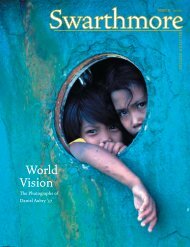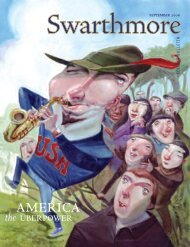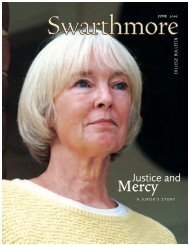Swarthmore College Bulletin (June 1998) - ITS
Swarthmore College Bulletin (June 1998) - ITS
Swarthmore College Bulletin (June 1998) - ITS
- No tags were found...
Create successful ePaper yourself
Turn your PDF publications into a flip-book with our unique Google optimized e-Paper software.
higher education and the modern corporation.school like <strong>Swarthmore</strong>, says Winston,is that they allow the <strong>College</strong> tobe highly selective in choosing its students.<strong>Swarthmore</strong> and other topschools have significant excessdemand for their services (more than4,500 applied for 360 positions in theClass of 2002), but instead of expanding“production,” as any prudententrepreneur would do, the <strong>College</strong>becomes more selective in choosingthe students it serves.Students educate studentsWinston calls this “customer-inputtechnology,” and it’s another majordifference between higher educationand business. As anyone who hasstudied in a college like <strong>Swarthmore</strong>well knows, students help educatestudents—something known and documentedas the “peer effect.”“<strong>Swarthmore</strong> students set highstandards for each other,” says ProfessorMark Jacobs of the BiologyDepartment. “Particularly in seminarsthe pressure to do well is coming notfrom the professors as much as fromthe other students. This is somethingyou learn as a freshman here—thatthe juniors and seniors aren’t competingwith you for grades but are passingalong their expectations for excellence.”Winston shows that the schoolswith greater subsidies from endowmentand contributions are able toattract better students, who, in turn,bring more of the same, creatinggreater demand and further raisingthe quality of education.A key component in bringing thebest students to <strong>Swarthmore</strong>, regardlessof their ability to pay, is financialaid. Scholarship grants have a longhistory at the <strong>College</strong>. Even in 1933,Mabel Lee received a $350 scholarship,for which she was required towork eight hours each week in thelibrary. Though the <strong>College</strong>’s annualfee was then $950, actual price paid byher family—Lee’s father was afarmer—that year was $600.In the academic year just completed,<strong>Swarthmore</strong> provided financial aidto just under half of its students. Theaverage financial aid package, consistingof outright grants, loans, and campuswork, was just shy of $21,000, andthe grant portion itself—essentially agift—averaged almost $17,000. Thusthe average price paid by the aidedfamily was $10,200, a little over a thirdof the “sticker price.”In sum <strong>Swarthmore</strong> and its peerinstitutions use their donated resourcesto add value to their programsand to create subsidies, whichfurther enhance their reputation.They choose their student bodiescarefully from an applicant pool thatfar exceeds their enrollment capacity,using financial aid to assure that onlythe brightest, most able studentsmatriculate. A “feedback loop” is created,raising the school’s reputationever higher, attracting evenbetter students and facultymembers—and more donationsto sustain the process.Infinite-life institutionAll of this is made possible,at least at the top ranks ofAmerican higher education,by philanthropy. “This is aninfinite-life institution,”asserts Paul Aslanian. “Peoplewho have gone throughhere before have believedin this place and have madeit possible for these studentstoday to be here.“I sometimes wish thatmembers of the facultywould stand in front oftheir classes and explain totheir students—even thosewho are paying the fullprice—that not one of themis paying the full cost, and that it’s thecommitment of their predecessorsthat has made all this possible. It’s notan economic calculus; it’s a moralargument to say that you have thesame obligations to future generations.”■<strong>Swarthmore</strong> usesits donatedresources to createsubsidies, whichfurther enhance itsreputation. It selectsstudents from anapplicant pool thatfar exceeds itsenrollment capacity,using financial aid toassure that only thebrightest, most ablestudents matriculate.JUNE <strong>1998</strong> 23
















